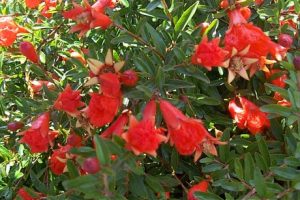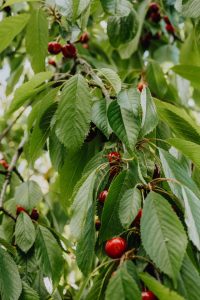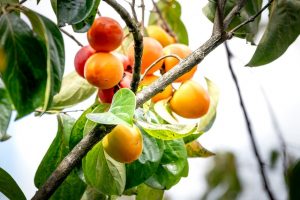By Debbie Arrington
Guest Writer
When temperatures go up, fruit starts to drop. And this summer, so do branches.
Fruit drop and limb drop (when tree limbs break and fall off) are both signs of heat stress in fruit trees, a staple of backyard gardens throughout the greater Sacramento area.
Sacramento County master gardener Quentyn Young has seen the effects of triple-digit heat in the demonstration fruit orchard at the master gardeners’ Fair Oaks Horticulture Center.
“We lost quite a few branches from a combination of heat and high winds,” says Young, a longtime professional nurseryman who oversees the 60-tree orchard.
Sudden fruit drop – which often happens during early triple-digit days in summer – is another sign of heat stress.
“One of our citrus trees dropped all its fruit all at once, and that’s not uncommon,” Young said. “When something happens like that, you also have to ask: Did you stop watering it? Was that tree getting its water from a nearby lawn that’s now not getting watered? Or is there something wrong with your irrigation?”
These are important questions especially now, as drought prompts many people to water their lawns less.
If fruit is ripening on the tree, wait to cut back on irrigation, if possible. Developing fruit needs that water, and so does the tree during this period. After harvest, the tree will be better able to withstand a drastic reduction in irrigation.
Other signs of heat stress: Brown edges on leaves or curling foliage. Heat-stressed fruit trees also tend to attract spider mites.
Many fruit trees had a heavy fruit set this spring. All those baby plums and peaches stress branches, too.
“Regular thinning helps trees,” explains Young, who also is manager of Fair Oaks Boulevard Nursery in Sacramento. “There’s less stress on the limbs – you’re taking off weight – and the tree will need less water. That’s important during drought like right now.
“Thinning also helps set a better harvest next year,” Young adds, “so you’re helping your tree with two harvests at the same time.”
At the Fair Oaks Horticulture Center, the master gardeners experiment with techniques of care as well as testing varieties for hardiness, disease resistance and flavor.
Says Young, “We grow a lot of fruit: Peaches, nectarines, plums, pluots, pluerries, cherries, apples, pears, Asian pears, avocado, atemoya, pawpaw, guavas, figs, pomegranates, persimmons and all kinds of citrus.
“We’re having a really good fruit year, especially peaches and plums,” he adds. “(Ripening) is maybe running a week early, but it’s pretty close to our harvest guidelines.”
The master gardeners keep their fruit trees short – under 7 feet. That makes their harvest easier to pick (no ladders necessary) as well as reduces the water needs of each tree. (There’s less tree!)
For irrigation, this little orchard uses microsprayers, explains Young. “They’re usually deep watered once a week; in July and August, twice a week if needed. The microsprayers put out 25 to 35 gallons an hour, so they run about an hour. We budget 25 gallons per tree per week.”
Young trees (under 3 years old) may need extra water to get established; figure an extra 5 gallons per week.
To retain that moisture and keep roots comfortable, use lots of mulch. That also keeps down water-robbing weeds.
“Mulch definitely helps,” Young says. “We have layers and layers of wood chips, a mix of everything (Sacramento County) crews chipped. We put down a fresh layer two or three times a year.”
Some fruit trees get by with less water better than others; in fact, they prefer it, Young notes. “All the biblical fruit: Olives, almonds, pomegranates, grapes, dates, figs. They’re native to the Mediterranean or desert regions. (Most varieties) require very little water. Everything else needs weekly irrigation.”
Tips for saving water around fruit trees
Sacramento County master gardeners recommend these ways to save water this summer while keeping fruit trees healthy and productive:
- Prioritize your fruit trees. Young trees that are still developing need regular irrigation. Pay special attention to rare specimens or sentimental favorites; those are the trees you want to keep healthy.
- Remove dying or non-producing fruit trees. This is a good time to make some decisions. Replant with a water-wise (or more productive) alternative in fall or spring.
- Prune overgrown trees – but not too hard or all at once. Over-pruning adds to tree stress. Instead, reduce the tree’s height by no more than one third, pruning a little more each year for three years. Do this after they finish fruiting.
- Irrigate early in the morning to cut down on evaporation. Water deeply, then wait until soil feels dry 4 to 6 inches below the surface. (Take a trowel and look.)
- Skip the fertilizer. It prompts fast growth and that needs more water.
- Mulch around fruit trees with bark, wood chips, leaves or straw, about 3 to 4 inches deep. Avoid mounding mulch around the trunk; instead, clear a circle about 6 inches away from the tree.
- Unwanted plants under trees compete for water.
Which fruit trees need the least water?
- Most drought tolerant (water deeply once or twice a month): Almonds, figs, olives, persimmons, pomegranates.
- Moderately tolerant (water twice a month or once a week): Apples, apricots, cherries, pears, prunes, walnuts.
- Least tolerant (water weekly or twice weekly): Nectarines, peach, citrus.
Source: UCCE Master Gardeners of Sacramento County
Debbie Arrington is a longtime home and garden reporter and co-author of the blog Sacramento Digs Gardening: https://sacdigsgardening.blogspot.com/




